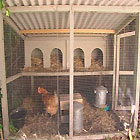Dr Chris Brown has a pet chicken. Her name is Juliet, and she is an ISA Brown. If you have an average sized backyard, you’ve got enough space to keep some chooks. Three to five pullets are all you need to keep a small family in a regular supply of eggs. Great for the kids, a few chooks can also be enormous fun and the kids get to learn a bit about handling animals and responsible care.
Housing
The ideal enclosure for chooks should firstly have a zone at the back, the coop, typically made out of galvanised iron or waterproof material. This gives the birds protection from the weather, particularly in winter. Each laying hen requires a minimum space in the coop of about 0.37 sq m. Ordinary straw can be used for floor litter in the coop. This is cheap to buy and will be used by the birds to build nests.
Ideally the chook run should face north so they can get out into the sun. The general run can be simply made of wire and should be buried to a depth of around 30cm (12″) to keep foxes out. Just because you may live in the city don’t think you are free of foxes. There are many times more foxes per hectare in all of the cities of Australia than there are in the country.
Feeding
Feeding and caring for your chooks is pretty simple. You can use pre-mixed grain diets, but it is more economical and efficient to feed layer pellets. These are available in different mixes for your adult and younger chooks. Chickens also adore kitchen scraps. Otherwise, just provide a little bit of shell grit in the diet and of course fresh water.
Maintenance
Clean the coop weekly. Excrement should be removed, water containers washed and dirty or wet litter replaced. Worm chickens once every three months and, if an occasional lice problem occurs, spray the inside of the chook shed with Coopex.
Health and lifespan
There are a number of diseases which the birds should be vaccinated against by the producer before you buy them. These include Marek’s disease, fowl pox, infectious bronchitis and Newcastle disease. Birds should also be wormed and deloused.
Healthy birds can survive for around 10 years, however their egg laying potential is greatly reduced as they get older.
Costs Point of lay birds (around 18 weeks to 21) cost around $15, including vaccination and worming. One chicken costs about $2.20 per week to feed. Feed is available from produce and larger pet stores, for about $22 for 40 kg. A sachet of Coopex retails for around $7.50 from produce and larger pet stores.
Note: Council regulations on keeping chooks can vary. Most councils don’t regulate specifically against the keeping of chickens, although roosters are banned in most domestic areas.
The ideal enclosure for chooks should firstly have a zone at the back, the coop, typically made out of galvanised iron or waterproof material. This gives the birds protection from the weather, particularly in winter. Each laying hen requires a minimum space in the coop of about 0.37 sq m. Ordinary straw can be used for floor litter in the coop. This is cheap to buy and will be used by the birds to build nests.
Ideally the chook run should face north so they can get out into the sun. The general run can be simply made of wire and should be buried to a depth of around 30cm (12″) to keep foxes out. Just because you may live in the city don’t think you are free of foxes. There are many times more foxes per hectare in all of the cities of Australia than there are in the country.
Feeding
Feeding and caring for your chooks is pretty simple. You can use pre-mixed grain diets, but it is more economical and efficient to feed layer pellets. These are available in different mixes for your adult and younger chooks. Chickens also adore kitchen scraps. Otherwise, just provide a little bit of shell grit in the diet and of course fresh water.
Maintenance
Clean the coop weekly. Excrement should be removed, water containers washed and dirty or wet litter replaced. Worm chickens once every three months and, if an occasional lice problem occurs, spray the inside of the chook shed with Coopex.
Health and lifespan
There are a number of diseases which the birds should be vaccinated against by the producer before you buy them. These include Marek’s disease, fowl pox, infectious bronchitis and Newcastle disease. Birds should also be wormed and deloused.
Healthy birds can survive for around 10 years, however their egg laying potential is greatly reduced as they get older.
Costs
Point of lay birds (around 18 weeks to 21) cost around $15, including vaccination and worming.
One chicken costs about $2.20 per week to feed.
Feed is available from produce and larger pet stores, for about $22 for 40 kg.
A sachet of Coopex retails for around $7.50 from produce and larger pet stores.
Note:
Council regulations on keeping chooks can vary. Most councils don’t regulate specifically against the keeping of chickens, although roosters are banned in most domestic areas.



